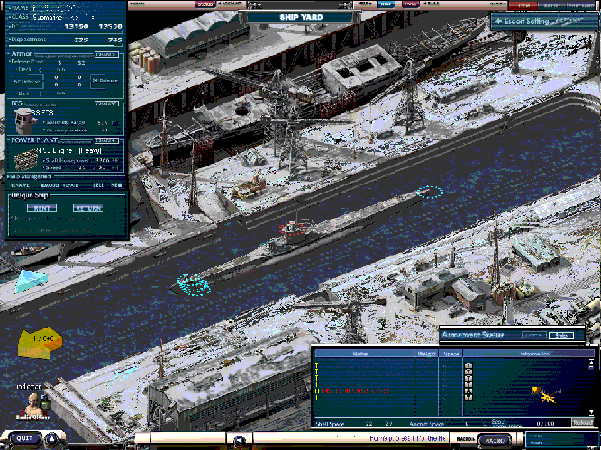First launched in June 1936, the Type VII was not the best submarine in any particular aspect, but it was the most successful of the war and formed the backbone of the U-boat force. Like many other military designs, the original Type VII was quickly modified to provide longer range, better performance and revised armament. These additional variants resulted in an improved torpedo attack boat (VIIC), minelayer (VIID), supply boat (VIIF) and other variants such as Flak and repair boats. 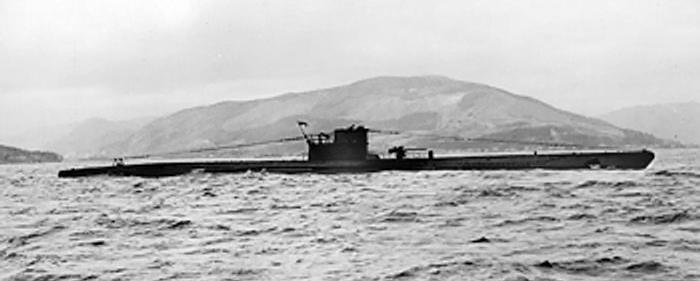
Kreigsmarine Submarines - Type VII Class ==========================================================================

Type VII U-boats were the workhorses of the German World War II U-boot-waffe. Type VII was based on earlier German submarine designs going back to the World War I Type UB III, designed through the Dutch dummy company Ingenieurskantoor voor Scheepsbouw den Haag (I.v.S) (set up by Germany after World War I in order to maintain and develop German submarine know-how and to circumvent the limitations set by the Treaty of Versailles) and built by shipyards around the world; the Finnish Vetehinen class and Spanish Type E-1. These designs led to the Type VII along with Type I, the latter being built in AG Weser shipyard in Bremen, Germany. The production of Type I was cut down only after two boats, the reasons for this are not certain and speculations range from political decisions to faults of the type. The design of the Type I was however further used in the development of the Type VII and Type IX. Type VII submarines were the most widely used u-boats of the war and were the most produced submarine class in history, with over 700 built. The type had several modifications.
There were several reasons which contributed to the selection of the Type VII as the main workhorse of the U-boat force. Technically, the Type VII had the necessary range, sea worthiness, armament, and maneuverability suitable to conduct a trade war in the North Atlantic. In order to build sufficient numbers in a war situation, the Type VII also had to be relatively cheap and quick to build. The number of sailors required to man the boat also had to be comparatively small. Crew habitability, however, was very low on the priority list.
Beyond the technical aspects, Naval policies also had an influence in the selection process. Under the Anglo-German Naval Agreement, Germany was allowed to construct submarines up to 35 percent tonnage of that of the Royal Navy. This figure was later increased to 100 percent. Since the Type VII was a medium-tonnage boat, this meant that more could be built under the existing tonnage restrictions.
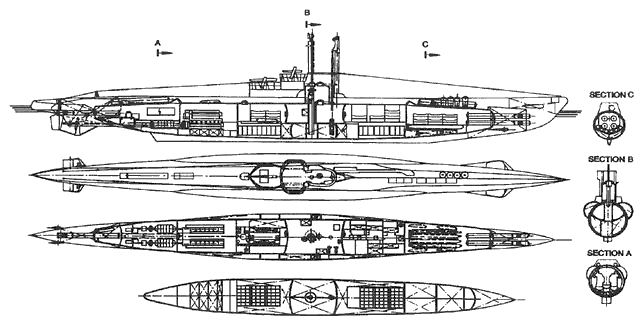
A total of 709 Type VII U-boats of all variants were built during the war – this was more than any other submarine built by any other nation. There were seven main variants, Type VIIA, VIIB, VIIC, VIIC/41, VIIC/42, VIID and VIIF.
The Type VIIA boats were designed in 1933 until 1934 as the first of a new generation of attack U-boats. Most were built at Deschimag AG Weser in Bremen with U33-36 built at Germaniawerft at Kiel. They were popular with their crews and much more powerful than the smaller Type II U-boats they replaced, with four bow and one external stern torpedo tubes. Usually carrying 11 torpedoes onboard, they were very agile on the surface and mounted the 88 mm fast-firing deck gun with about 220 rounds.
Ten Type VIIA boats were built between 1935 and 1937. All but two Type VIIA U-boats were sunk during World War II (U-29 and U-30, both scuttled in Kupfermühlen Bay on 4 May 1945).
The boat was powered on the surface by two MAN AG, 6 cylinder, 4-stroke M6V 40/46 diesels giving a total of 2,100 to 2,310 brake-horsepower (1,700 kW) at 470 to 485 rpm. When submerged it was propelled by two BBC GG UB 720/8 electric motors giving a total of 750 hp (560 kW) at a 322 rpm.
The only significant drawback of the VIIA was the limited fuel capacity, so 24 Type VIIB boats were built between 1936 and 1940 with an additional 33 tons of fuel in external saddle tanks which added another 2500 miles (4625 km) of range at 10 knots (19 km/h) surfaced. They were slightly faster than the VIIA, and had two rudders for even greater agility. The torpedo armament was improved as well by moving the aft tube to the inside of the boat. Now an additional aft torpedo could be carried below the deck plating of the aft torpedo room (which also served as the electric motor room) and two watertight compartments under the upper deck could hold two additional torpedoes giving it a total loadout of 14 torpedoes. Type VIIB included many of the most famous U-boats of World War II,

The Type VIIC was the workhorse of the German U-boat force, with 568 commissioned from 1940 to 1945. Boats of this type were built throughout the war. The first VIIC boat commissioned was the U-69 in 1940. The Type VIIC was an effective fighting machine and was seen almost everywhere U-boats operated, although their range was not as great as that of the larger Type IX. The VIIC came into service as the "Happy Time" at the beginning of World War II was almost over, and it was this boat that saw the final defeat by the Allied anti-submarine campaign in late 1943 and 1944. Perhaps the most famous VIIC boat was U-96, featured in the movie Das Boot.
Type VIIC was a slightly modified version of the successful VIIB. They had very similar engines and power, but were larger and heavier which made them slightly slower than the VIIB. Many of these boats were fitted with the Schnorchel in 1944 and 1945. They had the same torpedo tube arrangement as their predecessors.
Type VIIC/41 was a slightly modified version of the successful VIIC and had the same armament and engines. The difference was a stronger pressure hull giving them a deeper test depth and lighter machinery to compensate for the added steel in the hull, making them actually slightly lighter than the VIIC. A total of 91 were built.
The Type VIIC/42 was designed in 1942 and 1943 to replace the aging Type VIIC. It would have had a much stronger pressure hull, with skin thickness up to 28 mm, and would have dived twice as deep as the previous VIICs. These boats would have been very similar in external appearance to the VIIC/41 but with two periscopes in the tower and would have carried two more torpedoes.
Contracts were signed for 164 boats and a few boats were laid down, but all were cancelled on 30 September 1943 in favor of the new Type XXI.
The Type VIID boats, designed in 1939 and 1940, were a longer version of the VIIC with three banks of five vertical tubes just aft of the conning tower, rather like a modern ballistic missile submarine, except that these tubes ejected mines rather than missiles.
These boats did not fare well: only one survived the war; the other five all went down with all hands.
The Type VIIE was a purely experimental version to test the performance of a newly developed German lightweight V-12, two stroke diesel engine. The weight savings from a lightweight engine would have been used in a thicker pressure, allowing for greater diving depths. The engine program however was terminated and the Type VIIE was never laid down.
The Type VIIF boats, designed in 1941, were primarily built as torpedo transports. They were the largest and heaviest type VII boats built. They were armed identically with the other Type VIIs except that they could have up to 39 torpedoes onboard and had no deck guns.
Only four Type VIIFs were built. Two of them, U-1062 and U-1059, were sent to support the Monsun U-boats in the Far East; U-1060 and U-1061 remained in the Atlantic.
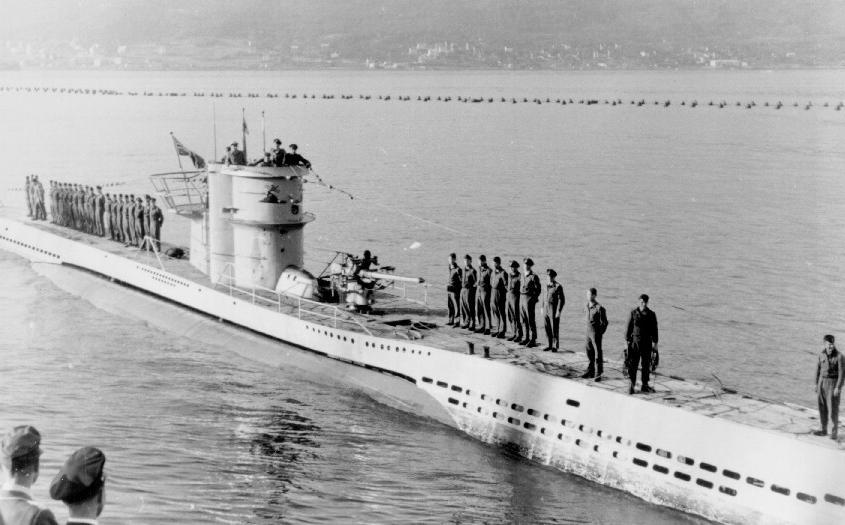

When one considers that during the war more than half of all the U-boats sunk at sea were sunk by aircraft it's no wonder the AA defence was a priority, not to mention the fact that the U-boats (until the Schnorchel and the Elektro boats came along) had to spend many hours on the surface recharging batteries and getting fresh air into the boat. Often the commander elected to fight it out and sometimes succeeded in shooting down the aircraft. 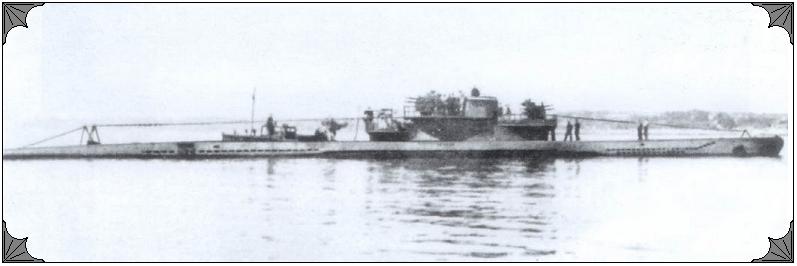
Kreigsmarine Submarines - U-FLAK Class ==========================================================================
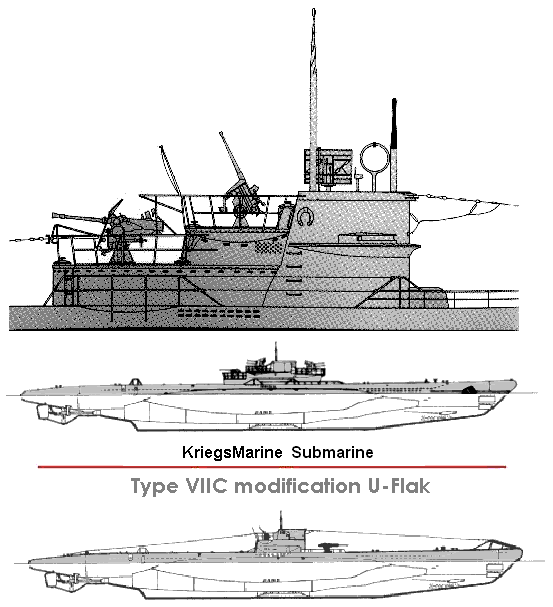
Around 120 aircraft were shot down by U-boats for the loss of roughly 30 U-boats either sunk during the attack or due to being located by other forces shortly afterwards and sunk.
One source says that RAF Coastal Command (U-boat hunters) lost 700 aircraft (badly damaged, shot down and paid off) and sank 220 U-boats during the war. I've been unable to verify the RAF losses but the U-boat figure is about right it seems. These figures show the immense effort put out by the British to hunt down the U-boats and almost all the aircraft successes took place in 1942 and later. In 1939-1941 only some 2 U-boats were sunk by aircraft (31 in 1942 alone).
But even the example above was not enough of a defence against a determined attack from many aircraft and eventually the only real option the U-boat had was to dive immediately and hope for the best. From late 1944 when most combat boats had been fitted with the Schnorchel (snorkle) device they spent more and more time beneath the surface and the AA guns went mostly silent.

At the beginning of the war, allied airpower was weak or non-existent. Hence the standard anti-aircraft armament of a single 20mm flak was sufficient to ward off most air attacks. The 20mm gun was not waterproof, which meant that it had to be stowed away in a vertical watertight casing before diving, increasing the amount of time required for the boat to dive.
When surprised on the surface, U-boat crews usually put up a good fight and shot down many aircraft, but as the war progressed, allied airpower increased rapidly and it became clear that the single 20mm flak gun was inadequate. Urgent steps had to be taken to increase the boat’s anti-aircraft capability, giving rise to a number of conversions.
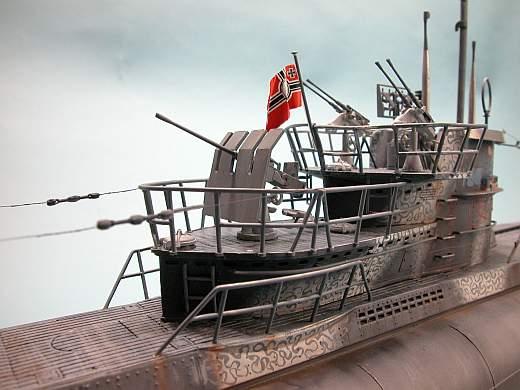
The first improvement consisted of the addition of extra anti-aircraft guns mounted in twin and even quadruple configuration. These were mounted on a slightly lowered platform on the forward and aft of the conning tower. These platforms came to be known as “wintergarden”. When these also proved inadequate, an even heavier twin 37mm flak was tried, but even this was not enough to stop a determined pilot.
Finally, a specialized Flak U-boat was designed as the ultimate solution to counter the air threat. Similar to role played by the mechanized anti-aircraft division of the German army – which was to provide air defense for surrounding units. The Flak U-boats were intended as mobile air defense units for other U-boats in the vicinity.
A total of seven U-boats, all of the Type VIIC class were converted to Flak variants. First launched on May 22 1943, their orders were to shoot down any allied aircraft encountered. Though they had some early successes in the Bay of Biscay, it was soon realized that the operational concept of the Flak U-boat was flawed and they were of no value in the North Atlantic.

The U-flak boats were 4 VIIC boats (U-441, U-256, U-621 and U-953) that were modified to act as surface escorts for the incoming/outgoing attack u-boats operating from the French Atlantic bases. They had greatly increased anti-aircraft fire-power and were intended as aircraft traps.
3 more additional U-boats were also taken aside for conversion to U-flak boats (U-211, U-263 and U-271) but none of them were completed as Flak boats although conversion did certainly start on all of them. They were eventually returned to duty as traditional VIIC attack boats.
The modifications took place in 1943 and the boats became operational in June 1943 and had excellent early successes against the surprised RAF aircraft. However the effort gave the Germans only about 2 months of limited freedom though until the RAF developed counter-measures where they called in surface hunters to assist the aircraft and the U-flak boats were withdrawn and converted back into fighting vessels.
In November 1943 -- less than six months after the experiment began -- all U-flaks were converted back to normal attack boats. At the same time, the standard anti-aircraft armament for U-boats was no longer much inferior to U-flaks, and the U-flaks had not been particularly successful. According to German sources only two aircraft had been shot down by U-flaks in six missions (three by U-441, one each by U-256, U-621, and U-953).

U-flak - the origins of the idea
The concept of the U-flak began the year before, on August 31, 1942, when U-256 (on her first cruise sailing from Kiel on 28/07/42 to proceed to Lorient via the North Atlantic) was seriously damaged by aircraft attack.
Rather than scrap the boat, it was decided to refit her as a heavily-armed anti-aircraft boat intended to stop the losses in the Bay of Biscay inflicted by Allied aircraft. Thus was born the concept of the U-flak - a heavily AA armed boat intended to lure unsuspecting aircraft to a deadly trap. It was expected to stop heavy losses in the Bay of Biscay inflicted by Allied aircraft by deploying a number of U-flaks.
Although U-256 was the first boat to be converted into a U-flak, the reconstruction was delayed. In the meantime, on 16/04/43, it was decided to convert U-441 in the same way. The third and fourth Flakvierling mounts available (20mm quadruple sets) and the first experimental 37mm automatic gun were installed on U-441. Also, a battery of 86mm line-carrying AA rockets was installed (but this idea proved unworkable).
It is sometimes indicated that two additional single 20mm guns were also carried. The fuel capacity was limited to Bay of Biscay operations only. Only 5 torpedoes were carried - in the tubes - for self-defence (since room was needed for the additional gunners taken aboard to operate the AA battery).
U-441 was a German World War II Type VIIC submarine commissioned on 21 February 1942. In April-May 1943 U-441 was rebuilt as the first of three U-Flak boats, designed to give U-boats a better chance of defending against aircraft attacks. U-441 was equipped with an enlarged bridge, which served as a base for two Flakvierling 2cm (four-barrelled) Flak guns and one 3.7cm Flak gun, as well as a number of machine guns. U-441 was redesignated U-Flak 1, and operated as U-Flak 1 from 1 May 1943 to 1 November 1943.
Flak-U1 or U-441 sailed on 22/05/43 from Brest on her 5th patrol commanded by KL Goetz von Hartman. On 24/05/43 U-441 was attacked by Sunderland 'L' of Sq 228, shot the aircraft down but got seriously damaged by aerial depth-charges and was forced to return arriving on 26/05/43.
The effectiveness of improved AA weaponry was overestimated and resulted in ordering U-boats to pass the Bay of Biscay on the surface in groups. This in turn resulted in heavy losses due to the group tactics adopted by the Allied aircraft.
The Flakvierling quadruple barrel 20mm anti-aircraft gun was a lethal weapon at close range. Allied pilots quickly learned to remain out of range of U-flak guns until multiple aircraft arrived to attack the boat in force.
U-441 again sailed from Brest on 8/07/43. On 12/07/43 she was attacked by Beaufighters 'A', 'B' and 'V' of Sq 248 and ended up badly damaged with heavy casualties (10 men dead, 13 wounded) in spite of the initial heavy AA fire. U-441 returned on 13/07/43.
U-621 was converted into U-flak in June 43, after being damaged on her 4th cruise, by Liberator 'Q' of Sq 224 on 31/05/43. U-621 as U-flak sailed on 29/08/43 and scored no success on her 5th one month patrol. After being reverted to a normal flak armament she was damaged by aircraft on 6th cruise, by Liberator 'A' of Sq 59 on 13/01/44.
U-flaks were not able to fulfill their assigned mission in the Bay of Biscay - mainly because of the group tactics adopted by Allied aircraft (one can see the irony in this). According to the German war sources only 2 aircraft were shot down by U-flaks (and some damage inflicted on others) in 6 U-flak missions (3 by U-441, 1 by U-621, U-953 and U-256).
A number of problems were encountered with the Flak U-boats. First, the bridge structure had to be enlarged so that multiple anti-aircraft emplacements could be mounted. The enlarged structure added considerably to the top weight, causing stability problems, especially in rough sea conditions. Further, it added to the hydrodynamic resistance, increasing diving time and reducing underwater speed. More men on the top deck also meant that more time was needed to clear the deck during a dive. The additional anti-aircraft armament took up considerable space, so that only five torpedoes could be carried, while their reduced fuel bunkers meant that they could not operate in more distant waters. Finally, the final proof that Flak U-boats were conceptually flawed came when allied pilots developed new tactics to overcome these defenses. Appreciating that the AA defenses had been strengthened, allied pilots would circle just out of range of the flak guns while staying close enough bomb it effectively if it tried to dive. Rest assured that if the standoff continues long enough, other aircraft or surface ships will appear. As a result, the design was scrapped and all existing Flak U-boats were converted back to their original VIIC designs.
Because of the limited fuel capacity and torpedo load U-flaks were not suitable for normal operations. At the same time the standard AA armament for U-boats was improving to where it was no longer much inferior to that of the U-flaks. This and lack of success made U-flaks somewhat redundant.
In November 1943 it was decided to convert all seven of the U-flaks (not all were yet completed) back to normal attack boats.
Note: The number of U-flaks sometimes is given as greater than 7. The confusion may arise from the fact that many boats later carried extended AA armament, including additional guns installed forward of the bridge (and were therefore easily confused with U-flaks).

U-Boat Bridge Conversions & Designs
U-Boat Bridge Conversions or Bridge Designs referred to the different bridge layout used by the Type VII U-boat during the war. In order to accomodate a variety of different anti-aircraft weaponry, the original bridge design was modified, giving rise to at least seven different bridge conversions during the war.
At the beginning of the war, the standard U-boat anti-aircraft armament is a single 20mm Flak intended as a defensive measure against aircraft. Mounted on the main upper deck, aft from the Bridge, this position limited the arc of fire due to the obstructing bridge. It was eventually relocated to a platform just aft of the bridge.
By mid-1942, the very rapid increase in hostile aircraft made it clear that the single gun was an inadequate defense against enemy air attacks. This gave rise to numerous bridge conversions to improve the boat's air defense capability.
Bridge Conversion I
The original design sported a single 20mm mounted aft of the bridge on a slightly lowered platform. This platform became to be known as "wintergarten". The first improvement was the addition of two twin 15mm MG151 to the bridge. The MG151 was later replaced by twin Breda 13.2mm MGs.
Bridge Conversion II
Two single 20mm Flaks were mounted, one on the bridge and one on a lowered platform aft (wintergarten). This was considered a stop-gap measure pending the arrival of twin 20mms.
Bridge Conversion III
The Flak platform on the bridge was widened to accommodate two single 20mm Flaks to be mounted side-by-side. This conversion was applied only to the Type VIID.
Bridge Conversion IV
Intended as the ultimate solution to the air threat, most Type VIIs carried this bridge design, which became mandatory for all operational boats from August 1943.
This design consisted of two twin 20mm Flaks side-by-side on the bridge platform and either a quadruple 20mm or a single 37mm Flak on a lowered wintergarten aft of the bridge.
The quadruple 20mm Flak was fitted with a protective shield. The two twin 20mm and single 37mm were later also fitted with protective shields.
Bridge Conversion V
This was an extension of Bridge Conversion IV. An additional platform (wintergarten) was mounted forward of the bridge to accommodate additional anti-aircraft armament.
Only one boat had this design, U-362.
Bridge Conversion VI
Essentially the same as Bridge Conversion V, except the front wintergarten was slightly lowered and had open sides to improve underwater performance. Since all the clutter on the boat’s deck had adversely increased hydrodynamic resistance.
Only two boats had this design, U-673 and U-973.
Bridge Conversion VII
Two flak platforms were mounted, one fore and one aft of the bridge. Each platform accommodated a twin 37mm Flak cannon.
Bridge Conversion VIII
The final flak conversion which completely encircled the bridge. There were four platforms, one forward, one after, and two on each side of the bridge.
Undesignated Conversions
A handful of boats were allowed to outfit their custom anti-aircraft configuration. These were non-official designs and were not widespread.
=================================================================================
NB: The above text has been collected / excerpted / edited / mangled / tangled / re-compiled / etc ... from the following online sources :
KM - Type-VII U-boat - www.uboataces.com
KM - Type-VII U-boat - wikipedia article
KM - Type VIIC submarine U-flak - wikipedia article
KM - U-Flak AA U-Boats - www.battle-fleet.com
KM - U-Flak AA - www.uboat.net article # 1
KM - U-boat anti-aircraft - www.uboat.net article # 2
KM - U-Boat Bridge Conversions & Designs - www.uboataces.com article # 1
KM - Flak U-Boat - www.uboataces.com article # 2
KM - U-Boat Anti-Aircraft - http://warandgame.wordpress.com

